| |
Photographer,
Location |
Images |
Comments |
|
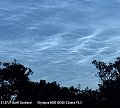
|
Doug
Hill,
Banff, Scotland
Jul. 11 |
#1 |
Very
bright noctilucent clouds. Looked like full moon behind
the clouds. Bright enough for the notoriously poor low light
auto focus of my Olympus 8080 to work (it usually can't
get a focus lock on a full moon). Looking north. |
|
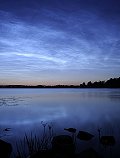
|
P-M
Heden,
Vallentuna, Sweden
Jul. 11 |
#1,
more |
A
fantastic Noctilucent cloud display, very strong with different
shapes and structures. I captured these photos with my Canon
DSLR. |
|
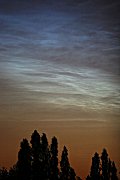
|
Koen
van Gorp,
Hove, Belgium
Jul. 14 |
#1,
#2, more |
This
display of NLC's was the brightest I've seen so far, very
nice structures and shades throughout the clouds made it
a sight not soon to be forgotten. Single shots and panorama
with
Photo
details: Canon
20D with 17-40mm and 70-200mm lenses. |
|

|
Tomasz
Adam,
Staszow, Poland.
Jul. 14 |
#1,
#2 |
I
saw these bright clouds while waiting for very bright Iridium
flare (about -8 mag). Too bad I couldn't go out to find
better place to take photos. The display lasted for only
1 hour.
Photo
details: Canon
PowerShot A520, ISO 200, 3 to 1s exposure. |
|

|
Peter
I. Papics,
Piszkesteto Observatory, Hungary
Jul. 14 |
#1 |
The
clouds were bright enough to see them right out from the
computer room located below the observatory dome.
Photo
details: 30s exposures at ISO 100. |
|
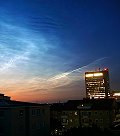
|
Peter
Rosen,
Stockholm, Sweden
Jul. 13 |
#1 |
Photo
details: Canon
EOS 20D, 10-22 zoom at 22mm, 10 secs at f/4.5. |
|

|
Vancanneyt
Sander,
Adegem, Belgium.
Jul. 14 |
#1,
more |
Fantastic
NLC display, this is the best I've ever seen, just wonderful!
|
|
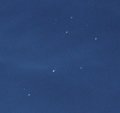
|
Martin
Mc Kenna,
Maghera, Co.Derry, N.Ireland
Jul. 13 |
#1 |
This
NLC display was the biggest I have ever seen in my life!
They climbed rapidly over head, showing no respect for the
zenith until they were 160* high and in the SE near the
moon. The 7 sisters were an exqusite sight against a background
of undulating NLC blue velvet. At one stage I could see
the shape of two silver stallions galloping side by side..unforgettable! |
|
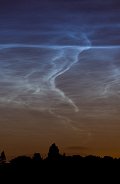
|
Peter
Urwin,
Edinburgh, Scotland
Jul. 13 |
#1,
#2 |
Another
sublime and beautiful display of Noctilucent Clouds is still
going on as I type. It's hard to tear myself away, but I've
got to get up for work in six hours! This has been the best
NLC season I can remember. Looking forward to finding out
more about these clouds when AIM goes up... |
|
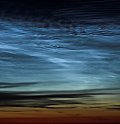
|
David
Kelly,
Taken from the cockpit of a 747 over northern Europe
Jul. 12 |
#1 |
My
first real look at noctilucent clouds. Very impressive.
Photo
details: Canon
EOS 20D with a 50mm f1.2 lens set at f2 iso 200 1/50
|
|

|
Eric
Krikke,
De Wieden in The Netherlands
Jul. 15 |
#1,
more |
Very
bright NLC display in The Netherlands. Panorama was made
from 6 photos.
Photo
details: 10 sec exposure, f/5.6, 400 ASA. |
|
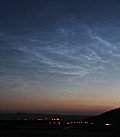
|
Grahame
Robertson,
Taken in Fife Scotland
Jul. 14 |
#1,
|
The
Noctilunent clouds were moving faster than I have usually
seen them and remained visible for a short time after the
sun went down. This picture was taken just before Midnight
BST.
Photo
details: Canon
EOS 20D and a 15 30mm lens at ASA 800. |